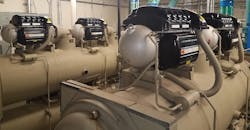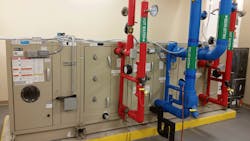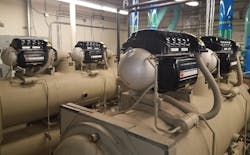Rebuilt School Finds Both Energy and Comfort via HVAC Technologies
By KEN KOEHLER and VICTOR SMITH
Danfoss North America
Baltimore MD
Like many older public schools, A.K. Suter Elementary School in Pensacola FL used a retrofitted patchwork of packaged and split system air-conditioning equipment to keep students comfortable in a warm, humid climate. However, to rejuvenate the almost 100-year-old building, the District decided in 2011 to tear down the school and rebuild it from scratch using new, high-efficiency HVAC technology.
Today, the new Suter Elementary is by far the most energy-efficient of all Escambia County School District (ECSD) schools — thanks in part to advanced HVAC technology, including Danfoss Turbocor oil-free centrifugal compressors and AB-QM valves.
“The new school has a lot of features found in high-performance buildings,” says Roger McGraw, PE, a mechanical engineer for ECSD Facilities Planning. “The walls are constructed with insulating concrete forms (ICF) and a vapor barrier, so the building envelope is well insulated. The new HVAC system is state-of-the-art — two ultra-efficient variable-speed centrifugal chillers with Danfoss Turbocor® oil-free compressors ensure efficient chilled water production. The chilled water is supplied to several AHUs and over 100 VAV boxes each using Danfoss AB-QM™ pressure-independent balancing and control valves to optimize flow. This combination of technologies inside the ICF building envelope saves energy and handles our major comfort challenge: humidity.”
Humidity dampens learning environment
Located in the Florida panhandle, Pensacola has some of the highest humidity levels in the state, which requires 68°F-78°F dry bulb set points for all student areas, in addition to some form of humidity control. But, the set point for indoor humidity is not defined. OSHA, however, recommends indoor air be maintained within 20-60 percent Rh, equivalent to a dew point of 24°F-60°F.
According to McGraw, “For elementary schools, our dry bulb set points are 72°F cooling and 70°F heating. But, our biggest challenge is always how to deal with humidity in an efficient manner. In the old school, we had split-system heat pumps and some packaged rooftop units. However, they were all very old, so we did not have that much control. Due to the humidity, the equipment was in all-cooling mode all the time. That’s one reason the energy bills were high.”
Older schools like A.K. Suter typically use over 85,000 BTUs per square foot per year and higher — an amount McGraw hoped to cut in half with the new school’s HVAC system.
The second biggest problem McGraw hoped to solve was zoning. “Zoning is critical for comfort,” he observes. “When you try to create separate zones for different areas, often it seems somebody, somewhere, is uncomfortable pretty much all the time. As a result, doing zoning right was a requirement for the new system design.”
VAV system with independent hydronic control loops
“To deliver conditioned air to classrooms, this design is based on using single-duct VAV boxes,” says Jeremy Oksanen, the project’s system designer and mechanical engineer with Premier Engineering Group, Pensacola.
Each single-duct VAV box is ducted to an air handler that contains a cooling coil with a 51°F-53°F set-point — cold enough for sufficient water vapor to condense on the coil for dehumidification, and then a reheat coil at the VAV box with a variable set-point to raise the air temperature to avoid overcooling. The supply air temperature is reset upwards based on humidity levels and valve position to reduce reheat.
“The damper control boosts efficiency by optimizing the volume of air needed to satisfy the room’s thermostat and avoid unnecessary heating and cooling,” Oksanen observes. “Classroom and administrative areas are served by multi-zone VAV air handlers. We put a dedicated VAV box in each classroom. Between each classroom, there’s a collaboration room for the teachers, which includes bathrooms and storage. That group of rooms also has a VAV box. For administration areas, there is about one VAV box per three offices. Corner offices, conference rooms or different thermostatic zones get a dedicated VAV box. And, the cafeteria gets its own single-zone AHU that can modulate airflow, outside air and capacity based on occupants.”
Just as fan dampers ensure proper air flow, valves are critical to control fluid flow.
The overall system employs supply air fans in AHUs to deliver conditioned air through ductwork connected to the VAV boxes. Then, return air fans circulate the air back to the AHUs.
The cooling coils and reheat coils in the VAV boxes are connected to a four-pipe, variable-primary hydronic system. Variable-speed pumps drive the chilled or hot water through the chiller or boiler loop to supply the coils inside the VAV boxes or AHUs. One pair of pipes circulates chilled water to coiling coils; another pair circulates hot water to reheat coils.
“It can be a challenge to balance and control water flow in a four-pipe system supplying numerous VAV boxes, especially in a variable-primary system where your conditions are constantly changing,” says Oksanen. He points out if the system is unbalanced, VAV boxes on some circuits will receive more water than required. In effect, those circuits “steal” flow from other circuits. The first circuits are in overflow, which creates underflow in other circuits. The underflow VAV boxes do not get sufficient chilled or hot water to meet the cooling and heating requirements.
Pushing pumps to the maximum is one way to solve the underflow problem. However, this simply increases pressure to increase total flow, which increases pump energy consumption and stresses pumps and valves. Another tactic is to adjust supply water temperatures to meet the requirements of the VAV boxes in the underflow circuits, but that also wastes energy.
Solving hydronic circuit balancing problems
“When you have variable primary systems, we can never depend on manual balancing valves,” McGraw observes. “That’s because the system rarely operates in the same conditions to allow manually balancing the system.
“Instead, we like using the AB-QM pressure-independent control valves. They replace the typical two-way balancing valve and control valve pair that usually get installed on the return flow side of VAV cooling and heating coils. For this project, every VAV box and AHU gets an AB-QM valve, totaling about 130 valves. The valves ensure flows are balanced in the entire operating range of the system.”
To balance the system, they incorporate an integrated differential pressure controller that enables stable control with 100 percent “authority.” As a result, at partial loads, there is no overflow because the valve will always limit the flow to exactly meet requirements. From a system design standpoint, this divides the entire system into completely independent control loops.
Segmenting the hydronic distribution piping into independent loops or “modules” ensures the design flow —which, in this case, is typically 6 GPM — is available at all the VAV terminal units at design temperature set points. Thus, the AB-QM valve is the key that unlocks the three requirements for optimal system balancing by: 1) supplying design flow to all terminal units at design conditions; 2) minimizing variation in the differential pressure (pressure drop) across the control valve; 3) ensuring the water flow is compatible with system components and interfaces.
Another benefit is the energy efficiency resulting from proper valve seating.
“In old buildings in our school district, there’s no telling how much energy gets wasted by leakage due to improper valve seating,” adds McGraw. “A central AHU may be pushing out 53°F air to a VAV box. However, if hot water is leaking through the valve into the reheat coil, the air is then being heated needlessly. Consequently, the damper on the VAV box opens to supply more and more air for cooling, so people are comfortable. But, it’s wasting a ton of energy. In contrast, the AB-QM valve automatically knows how to seat itself to a fully closed position. I don’t have to worry about it.”
Variable-speed oil-free chillers handle part-load problems
To generate chilled water at the 44°F setpoint, two water-cooled centrifugal chillers are employed, each using two Danfoss Turbocor TT400 variable-speed magnetic-bearing compressors. Each pair of compressors deliver 250 tons of nominal cooling capacity per chiller.
Together, the two chillers provide what is known as “N+1 redundancy,” meaning that one chiller is available as a standby or backup — as well as being available to provide additional capacity in the event of school expansion.
In day-to-day operation, the chillers take advantage of the Turbocor compressor’s extraordinarily high efficiency at part-load conditions.
McGraw calculates that the lead chiller runs at 60 percent capacity, 85 percent of the time, and below 20 percent capacity, nearly a third of the time. It goes above 80 percent capacity only 3.3 percent of the total operating hours.
That’s where the maximum benefits of the compressor’s magnetic-bearing variable-speed technology are realized.
With Turbocor compressors, the shaft/impeller speed is reduced and — in combination with the inlet guide vane assembly — capacity can be “turned down” to match the cooling load required. To reduce speed quickly and reliably, the Turbocor compressor uses a synchronous permanent-magnet brushless motor.
Each motor is integrated with a variable-speed drive that controls the voltage and amperage. VSD technology makes it easy to change speed by reducing the frequency of the current supplied to the motor. The VSD varies frequency between 300 and 800 Hz, which provides a compressor-speed range from 9,000-29,000 RPMs without using a gear set.
Efficiency is further enhanced by the oil-free magnetic bearings, which eliminate the friction associated with using traditional contact bearings. In a Turbocor compressor, the rotor is levitated in a magnetic field rather than riding on bearings coated with a film of oil.
The absence of oil lubrication eliminates the efficiency losses that can occur when oil fouls a chiller’s heat exchanger tubes. Tube fouling decreases heat transfer. One study shows that as little as 3.5 percent oil content in a refrigerant charge can reduce efficiency as much as 8 percent.
“Plus, with permanent-magnet motors, noise and vibration is minimal,” adds McGraw. “These chillers are so quiet, you hardly know they are running. They are perfect for a school environment.”
In oil-lubricated chillers, oil can enter the refrigerant circuit and accumulate in the evaporator when RPMs decrease. Normally, excess oil stays in the compressor’s oil sump. But, when RPMs drop, oil accumulates in the evaporator, which can cause the chiller to shut down. Otherwise, the excess oil tends to displace refrigerant at the top layer of evaporator tubes, further reducing heat transfer and chiller efficiency. Without these complications, the oil-free compressors achieve high stability and efficiency resulting in a high part-load efficiency.
Because 80 percent and higher capacity is required for only about 3 percent of the chiller’s operating hours, the high part-load efficiency means the chiller is saving energy during 97 percent of annual operating hours. For the A.K. Suter application, the chillers are consuming only about .45 kW per ton — nearly 50 percent less than a constant-speed chiller.
In the end, McGraw was delighted with the results. “The yearly energy use for old elementary schools in ECSD is over 0.080 MBTU per square foot,” he notes. “I was hoping the new A.K. Suter would drop at least 50 percent to below the elementary school average of 0.045 MBTU. The performance is stellar — just 0.024 MBTU per square foot, far below any public elementary or high school in Escambia County. That level of performance can be achieved with state-of-the-art building design and HVAC technologies. (So) we learned valuable lessons in efficient air and fluid flows that we look forward to applying in other schools.”



